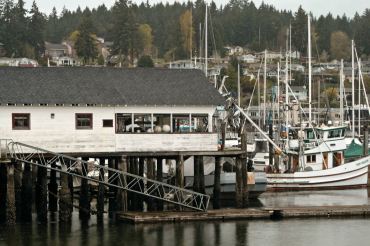 Shortly after the first commercial fishermen began settling in Gig Harbor, net sheds started dotting the waterfront. These wood structures, built on pilings, were simple but their long, rectangular shape made them distinct. For the fishermen, the net sheds provided a convenient way for loading and unloading the heavy nets from their boats so they could be hung and repaired.
Shortly after the first commercial fishermen began settling in Gig Harbor, net sheds started dotting the waterfront. These wood structures, built on pilings, were simple but their long, rectangular shape made them distinct. For the fishermen, the net sheds provided a convenient way for loading and unloading the heavy nets from their boats so they could be hung and repaired.
In those days, the nets were made of cotton — which meant they had to be taken apart every year and mended frequently — and there were no so-called “power blocks” (hydraulic equipment) to assist the crew in moving them. To prolong the nets’ life, once every season or two they were dipped in hot tar, and an entire waterfront area was designated for the process.
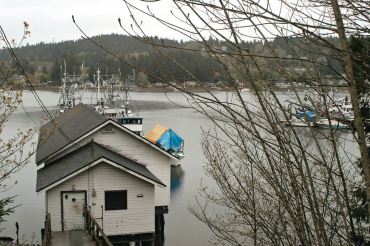 Much has changed in the industry since then, as third-generation Croatian families continue the commercial fishing tradition. By the 1950s, cotton was replaced by nylon while hydraulics and engines are used for tasks such as pulling the nets, which once required brute strength. As a result, crews have shrunk to four or five from as many as 10 people.
Much has changed in the industry since then, as third-generation Croatian families continue the commercial fishing tradition. By the 1950s, cotton was replaced by nylon while hydraulics and engines are used for tasks such as pulling the nets, which once required brute strength. As a result, crews have shrunk to four or five from as many as 10 people.
But one symbol of those early days of Gig Harbor’s booming fishing industry remains: working net sheds that are still used by fishermen when their purse seiners return home.
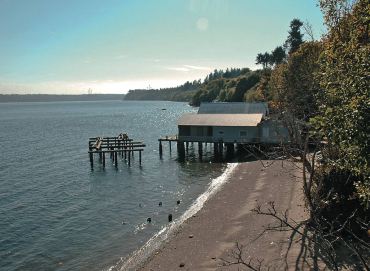
Carrying on the Tradition
The Lovrovich brothers — Gregg, Tim and Tom — are among the multigenerational fishing families. Their cousins, the Babiches, come from another line of Croatian settlers who continue to fish.
The Lovroviches spend a couple of months with their purse seiners in Alaska each summer and then fish in Puget Sound in the fall.
“We got into it because our dad fished and that’s what his dad did,” says Gregg, whose seiner is the ’57 wood-made Sea Fury.
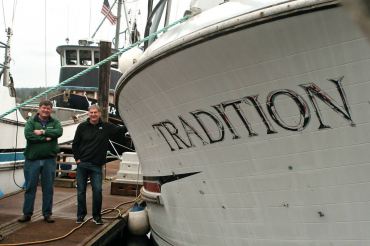
Prior to acquiring their net shed from the Morin family, they trucked the nets to their father’s yard to hang and they moored their boats at other docks. The net shed, built in 1952, is essentially a machine shop, dock and net-hanging area all-in-one. The brothers do their own welding and machining, among other things, so equipment of all kind is tucked into the corners of the shed.
“If you don’t do your own stuff in this business, you don’t make it,” Tom says.
The nets, which are deeper than in the past, weigh as much as 6,000 pounds, partly due to the led line attached to part of the web so it can sink to the bottom of the sea. The net is about 250 fathoms long (one fathom is 6 feet), which explains the net shed’s configuration — they were usually 60 or more feet long so the nets could be stretched more efficiently.
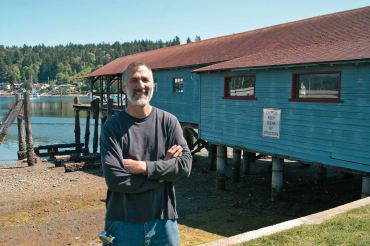
The 2,025-square-foot Lovrovich net shed is 90 feet long and includes a kitchen, which in the Morin days served as a place to feed the crew and to socialize.
“Net sheds have always been a big part of the character of Gig Harbor. If they disappear, it takes the charm away,” Gregg says.
Preserving the Character
Gig Harbor’s historic net sheds were listed on the Washington Trust for Historic Preservation’s Most Endangered Structures List in 2008. The 17 remaining structures comprise the largest inventory of its kind in Puget Sound and most are still working net sheds.
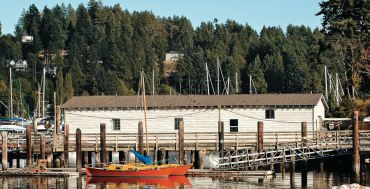
“There’s not a place where so many of them are left,” says Lita Dawn Stanton, the city of Gig Harbor’s historic preservation coordinator who comes from the Ancich family of Croatian fishermen. “We are different from other cities because the isolation has set us back and our surge of development began in the ’70s and ’80s instead of the ’30s and ’40s.”
This gives Gig Harbor the unique opportunity to preserve net sheds, which Stanton says are the maritime equal of farm barns. The city’s efforts include completing a detailed inventory of the historic net sheds and creating a self-guided tour. Plus, there’s the effort to preserve the crown jewel — the Skansie family net shed, now owned by the city along with the Skansie family home.
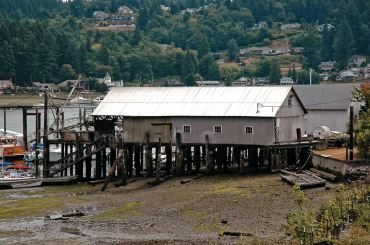
“Much of Gig Harbor has been gentrified and there’s not a lot of that heritage left. The Skansie net shed speaks to the heritage better than anything else that exists in Gig Harbor,” says Michael Vlahovich, founder and director of the Coastal Heritage Alliance.
Restoring the Jewel
The Skansie family homesteaded in Gig Harbor in the late 1800s, starting with Peter, who was later joined by three brothers. They developed a shipyard that became a major purse-seiner builder for Puget Sound’s fleets, and also built some of the state’s first ferry boats.
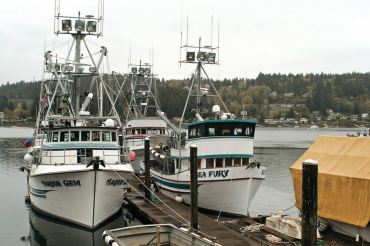 The Skansie home and net shed were built by Andrew Skansie and stayed in the family until the city’s purchase in 2002. Andrew’s sons, Antone, Vince and Peter, continued the family tradition; Antone got to skipper the family boat, the Avalon, which for years has been a Gig Harbor icon (and will soon return to the Skansie Brothers Park, which includes the home and the net shed).
The Skansie home and net shed were built by Andrew Skansie and stayed in the family until the city’s purchase in 2002. Andrew’s sons, Antone, Vince and Peter, continued the family tradition; Antone got to skipper the family boat, the Avalon, which for years has been a Gig Harbor icon (and will soon return to the Skansie Brothers Park, which includes the home and the net shed).
“All the fishing equipment the brothers used through the years was left in there. It became kind of a time capsule,” says Vlahovich, who started fishing out of Gig Harbor when he was 15. His boat, the Commencement, was built in the Skansie yard and since ’96 he’s been using it for education instead of fishing.
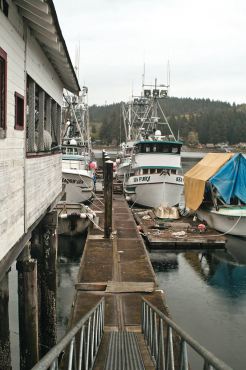 Now based on the East Coast in Chesapeake Bay and with family left in Gig Harbor, Vlahovich has returned to his roots, in a way. The nonprofit Coastal Heritage Alliance has inventoried the Skansie shed for the city and later won a bid to become the tenant and provide public programming.
Now based on the East Coast in Chesapeake Bay and with family left in Gig Harbor, Vlahovich has returned to his roots, in a way. The nonprofit Coastal Heritage Alliance has inventoried the Skansie shed for the city and later won a bid to become the tenant and provide public programming.
The objects left behind by the Skansies have been removed from the shed so its pilings could be restored. Some items dated back to 1910. The inventory included the shipping crate for Avalon’s engine, ship-skulking tools (currently on loan to the Gig Harbor museum) and even old cases of canned salmon.
The piling restoration is nearly complete, and the alliance plans to offer workshops, classes and other events starting later this year. One of the goals is to bring in fishermen like the Lovroviches to demonstrate and teach net-making and other skills.
“There’s definitely a need. We learned those skills from our grandfathers in net sheds. All those skills were passed down from the family but that’s pretty much gone,” Vlahovich says.
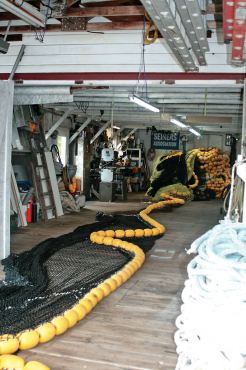 One of the reasons net sheds are disappearing, Stanton says, is financial. The waterfront properties are taxed for best use, not actual use. “It puts pressure on the families that want to pass them on to the next generation,” she says.
One of the reasons net sheds are disappearing, Stanton says, is financial. The waterfront properties are taxed for best use, not actual use. “It puts pressure on the families that want to pass them on to the next generation,” she says.
That’s one of the reasons Gig Harbor wants to hang on to this major part of its history, and telling the Skansie story is one way to do that. The home, which has been restored as well, will also have a nonprofit tenant and future programming.
“The whole site has a story and the fact that the story can be continued to be told to the community means the heritage of Gig Harbor will be alive,” Stanton says.
Vlahovich says young people are still drawn to the fishermen’s lifestyle but they don’t have the skills and knowledge to do it, and he sees the Skansie net shed filling that gap. It’s also a window into that lifestyle for the general public.
“(The net shed) is a magical place. I call it the maritime sanctuary,” he says. “For the fishermen, to step into the net sheds is stepping out of the modern world. It’s always been a getaway from the hubbub.”
More Information
To learn more about Gig Harbor’s net sheds and download a self-guided tour map, go to cityofgigharbor.net and follow the net shed survey link; the site also has details about the Skansie property. For information about the Coastal Heritage Alliance, visit coastalheritage.org.




























Comments